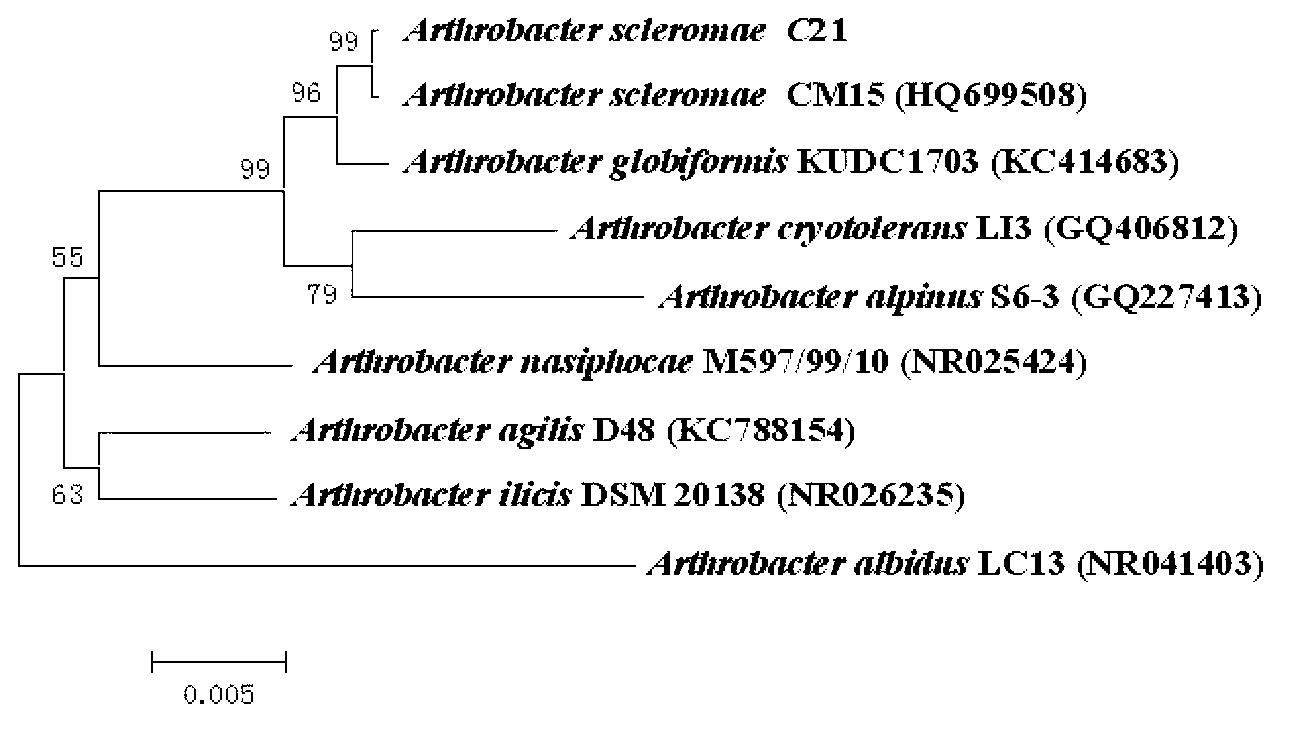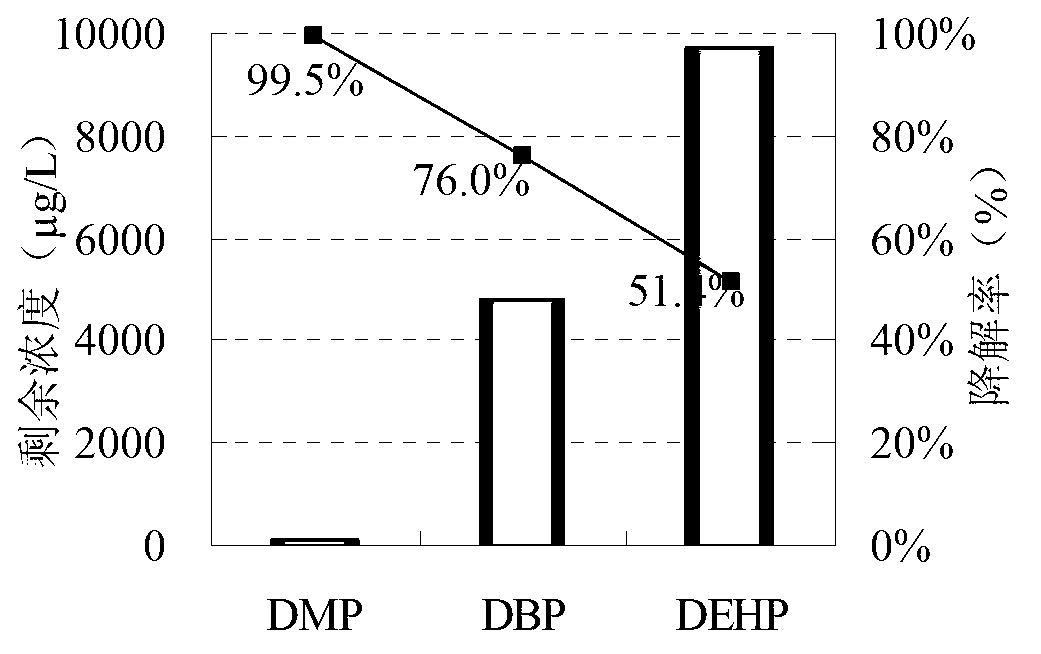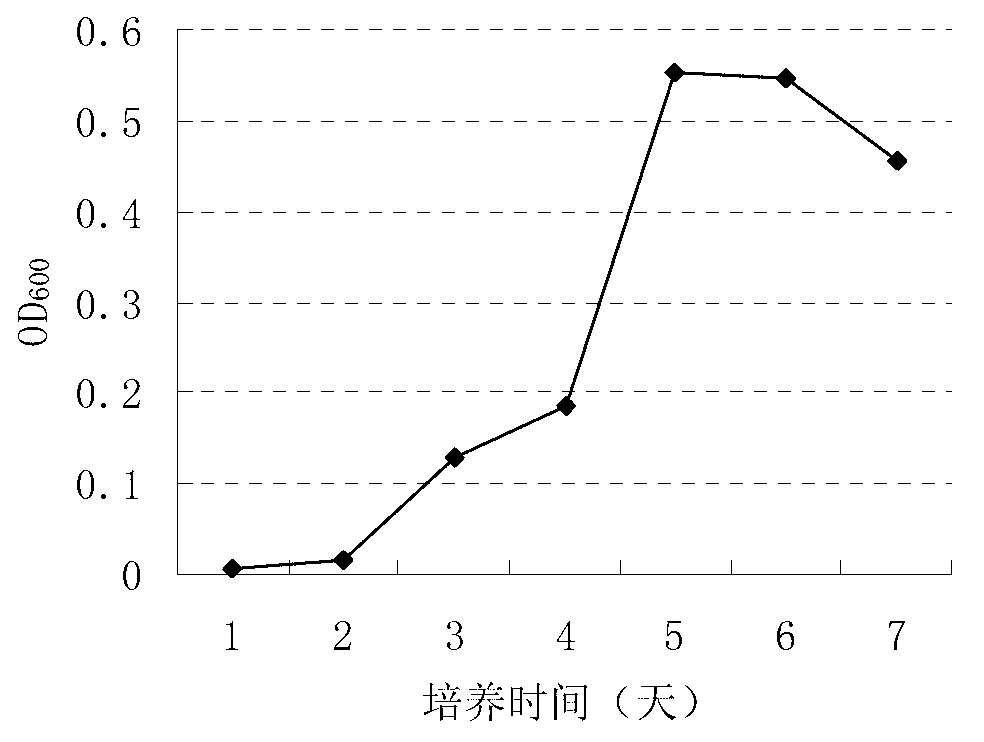Phthalate degrading bacteria and application thereof
A technology for phthalate esters and degrading bacteria, which is applied in the direction of bacteria, water/sludge/sewage treatment, biochemical equipment and methods, etc., and can solve problems such as microbial strains that have not yet been found to degrade phthalates , to achieve the effects of easy control of degradation conditions, avoidance of antagonism, and small environmental interference factors
- Summary
- Abstract
- Description
- Claims
- Application Information
AI Technical Summary
Problems solved by technology
Method used
Image
Examples
specific Embodiment approach 1
[0019] Specific Embodiment 1: In this embodiment, the phthalate-degrading bacterium is Arthrobacter scleromae C21, which belongs to the genus Arthrobacter; it is preserved in the General Microorganism Center of China Microbiological Culture Collection Management Committee, and the preservation number is It is CGMCC No.7671, and the deposit date is May 31, 2013.
[0020] Arthrobacter scleromae C21 is an obligate aerobic bacterium that can grow in an environment with a pH value of 5.5-9, and the optimum pH value is 7.0; the growth temperature is 10-35°C, and the optimum growth temperature is 25 ~30°C. Under the condition of 30°C, Arthrobacter scleromae C21 was enriched on a shaking table (120r / min) using beef extract peptone liquid medium, and it entered the logarithmic growth phase after about 12 hours of culture. 1 liter of the culture medium contains 10 g of peptone, 3 g of beef extract, and 5 g of sodium chloride, and the pH value is 7.0 to 7.2.
[0021] Arthrobacter scler...
specific Embodiment approach 2
[0028] Specific embodiment 2: In this embodiment, Arthrobacter scleromae C21 is isolated and obtained according to the following steps.
[0029] Step 1. Collect soil samples in a constructed wetland for domestic sewage treatment in Changtu County, Liaoning Province. The geographical location of the wetland is 124°4′44″N~124°4′59″N, 42°45′43″E~ 42°45′58″E. Before sampling, the utensils used were sterilized at high temperature, washed with acetone and ultrapure water, and rinsed with water samples from the sampling point before sampling. When sampling, first use a sterilized stainless steel sampling shovel to remove 10 cm of soil on the surface, and then take samples, and adopt the method of multi-point collection and mixed sampling. Add 5g of the collected soil sample into a 150mL sterile Erlenmeyer flask, and at the same time add the inorganic salt MSM culture solution with PAEs as the only carbon source to domesticate the PAEs degrading bacteria. The PAEs used are DMP, DEP, ...
specific Embodiment approach 3
[0032] Embodiment 3: In this embodiment, the phthalate-degrading bacteria Arthrobacter scleromae C21 can be used for the degradation of phthalate.
[0033] Dosing Arthrobacter scleromae C21 in the environment polluted by phthalates, the dosing and degradation are carried out under the conditions of an ambient temperature of 10-35°C and an environmental pH value of 5.5-9. In this embodiment, Arthrobacter scleromae C21 can be used for water body or soil remediation.
[0034] Arthrobacter scleromae C21 was cultured in beef extract peptone liquid medium, and the culture solution of Arthrobacter scleromae C21 was sprayed to the soil polluted by phthalates (the soil contains DMP, In DEP, DBP, BBP, DPP, DEHP, and DOP), the amount of spraying can be determined according to the degree of pollution. It was detected by microwave extraction that the content of PAEs in the soil began to decrease significantly after 3 days of spraying. In order to strengthen the restoration effect, the sec...
PUM
 Login to View More
Login to View More Abstract
Description
Claims
Application Information
 Login to View More
Login to View More - R&D
- Intellectual Property
- Life Sciences
- Materials
- Tech Scout
- Unparalleled Data Quality
- Higher Quality Content
- 60% Fewer Hallucinations
Browse by: Latest US Patents, China's latest patents, Technical Efficacy Thesaurus, Application Domain, Technology Topic, Popular Technical Reports.
© 2025 PatSnap. All rights reserved.Legal|Privacy policy|Modern Slavery Act Transparency Statement|Sitemap|About US| Contact US: help@patsnap.com



